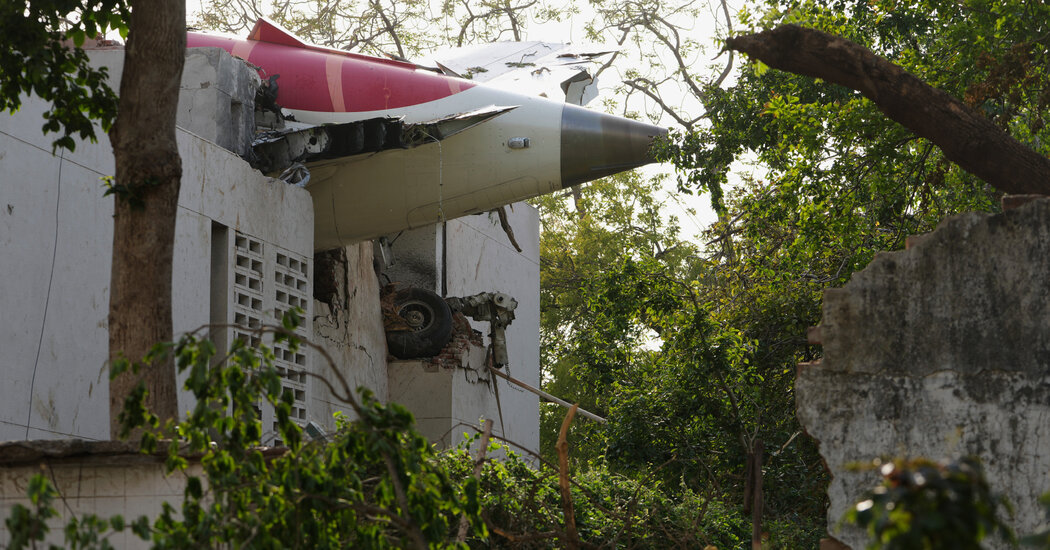Plane crash investigations are incredibly complex, and it can take months or even years to identify what went wrong. But video and photos of the Air India crash on Thursday prompted some early thoughts from aviation experts.
A widely shared video of the crash showed the Boeing 787 descending over buildings with its nose pointed upward, an unusual position, said John Cox, a former airline pilot and chief executive of Safety Operating Systems, a consulting firm.
The plane’s position looks as if “it should be climbing, and in fact it’s descending,” he said. “The question is why.”
Mr. Cox and other experts cautioned against jumping to conclusions. Planes and the aviation system have many redundancies to prevent a single problem from leading to a calamity. As a result, crashes are typically caused by multiple failures, which can include equipment malfunctions, improper maintenance, bird strikes or pilot error. Early hypotheses often are ruled out during lengthy, technical crash investigations.
Officials looking into the crash will have no shortage of questions to ask, said Greg Feith, a former investigator at the National Transportation Safety Board.
“Did they properly configure the airplane when it took off? What was occurring with them? Was there a loss of thrust?” he asked. “Was there fuel contamination? Fuel starvation where both engines weren’t getting fuel that would have caused a loss of thrust on both engines?”
The N.T.S.B., the lead U.S. agency in crash investigations, said it would send a team to India to help with the investigation, which will be led by India’s aviation authority. The Federal Aviation Administration said it would provide technical expertise and assistance, and its counterpart in Britain, where the flight was headed, made a similar offer.
In the video, the plane’s descent appeared to be controlled. That suggests that the pilots may have been trying to slow it down, said Ben Berman, a safety consultant who is also a former airline pilot and federal crash investigator in the United States.
“Any reduction you can make to the airspeed at impact is going to have a big positive effect,” he said. “It’s consistent with that, but it could also mean any number of other things.”
Heat is another consideration. The weather topped 100 degrees in Ahmedabad, the city from which the plane departed on Thursday. High temperatures make takeoffs more difficult because engines produce less thrust and warm air is less dense, making it harder for the airplane to generate lift.
While the full investigation could take more than a year, corrective actions could potentially arrive sooner, Mr. Feith said.
“The whole purpose of accident investigation is to identify safety critical issues — if there’s a problem with the airline, the crew, the airplane itself — you want to get those safety critical issues identified and corrective actions implemented sooner rather than later,” he said.
The plane’s black boxes should provide early insights, too. The information on the flight data recorder includes time, altitude, airspeed and heading. The cockpit voice recorder can offer clues about the moments leading up to the crash, including what the pilots were saying, engine noises, stall warnings or other equipment sounds.
“If they functioned correctly, they’ll give a tremendous amount of information, because the 787 has a huge number of parameters recorded,” Mr. Berman said.
That data could be recovered and assessed preliminarily within days, Mr. Cox said.
The footage of the plane’s descent is shaky and grainy, and it wasn’t clear whether the wing’s trailing edge flaps were properly extended as they typically would be when a plane is taking off, experts said. Those flaps and slats at the front of the wing are typically extended during ascent to provide more surface area and alter the shape of the wing to help lift the plane at relatively low speeds.
“In the video, you see the landing gear is still down, but the flaps look to be in a relatively up position,” Mr. Feith said. “That will have to be examined. Normally on a large aircraft like that, you need to use some level of flap deployment. If the airplane was not properly configured, that can present a performance issue.”
Mr. Berman said that typically pilots retract landing gear, which includes the plane’s wheels, quickly after taking off because it can create drag as the plane tries to climb, but not always. The brakes on a larger, heavier jet like the Dreamliner can get very hot and sometimes pilots may leave the landing gear down for a bit to cool them off, he added.
“It might have been intentional,” he said. “It might have been that they had a massive problem right after takeoff and they may have neglected to raise the gear. We’ll need to know a lot more about the airplane to comment on this intelligently.”
The crash on Thursday has some similarity to a 1987 one on Northwest Airlines Flight 255, which crashed in Michigan after the plane’s pilots failed to extend its wing flaps and slats for takeoff. After lifting off, that plane rolled to the left and right and then hit light poles and a rental car building before crashing, killing all but one person on board and several people on the ground. Despite some broad similarities, experts cautioned that the Air India crash could have been from any number of causes.
James Glanz contributed reporting.
Niraj Chokshi is a Times reporter who writes about aviation, rail and other transportation industries.
Christine Chung is a Times reporter covering airlines and consumer travel.
The post What Caused the Air India Crash? Experts Study Video of the Plane’s Descent. appeared first on New York Times.




